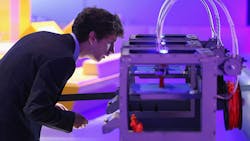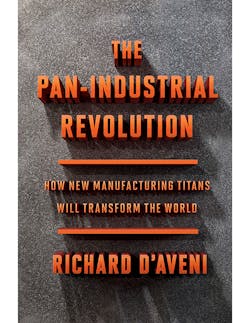Overcoming Internal Resistance to Additive Manufacturing
Back in the 1980s, Motorola was exploring adopting the then-emerging digital technology for cellphones. Its engineers, however, resisted the move. They were so entrenched in analog technology — much of it developed by Motorola itself — that they couldn’t see the advantages that digital technology would bring. As a result, Motorola’s engineers made only half-hearted efforts to incorporate digital technology, eventually causing the company to lose its once-formidable market share.
Today, a similar struggle is happening inside many companies in regard to additive manufacturing, industrial platforms, and other technological innovations. As you map out your plans for incorporating 3D printing and other new manufacturing technologies into your company’s toolkit, you may discover that you face significant resistance from engineers, managers, and others in your company who are psychologically or intellectually wedded to traditional manufacturing methods.
When this happens, it’s extremely helpful to have a concrete plan for overcoming that resistance and changing the internal culture.
One approach is what might be called the soft-touch approach. As an example, one giant aerospace company has been following a five-step path toward mastery of 3D printing technologies:
Step 1: Use 3D printing for prototyping in all departments, enabling engineers and designers to become familiar with its capabilities.
Step 2: Use 3D printing for tooling and design, making incremental improvements to traditional manufacturing methods.
Step 3: Build a 3D printing lab and partner with outside experts in order to gain increased knowledge and experience.
Step 4: Experiment with new materials for 3D printing and begin innovation in manufacturing methods.
Step 5: Start developing products with new functions and capabilities that take advantage of the new materials 3D printers can now use.
This path provides a concrete, logical way for knowledge of 3D printing and comfort with the technology to gradually spread throughout the organization, taking on a more important role in the life of the company with each new step. In effect, having a soft-touch program like this is a way of driving your company’s progress through the four phases of technology adoption rather than allowing trends to unfold passively — and doing so in a way that makes the cultural adaptation gradual and relatively painless.
Other companies, like GE (IW500/6), are taking what might be called the hard-touch approach. GE has been requiring every business unit to develop one or more pilot projects to experiment with new manufacturing technologies and to provide venues for retraining engineers, designers and researchers. Initiatives like these can help organizations develop the knowledge and experience needed to overcome internal resistance that will hamper some companies in their efforts to reap the full benefits that the manufacturing revolution offers. Because the shift to AM is driven by a mandate from the top of the organization, this hard-touch approach sends a strong signal throughout the corporation that AM is the wave of the future — and that everyone needs to be prepared to embrace it.
Perhaps the most important element in overcoming the resistance to change is leadership from the top of your organization. Vocal, visible support from the CEO and other C-suite leaders is necessary to create a sense of urgency about the coming transformation, its benefits, and its strategic and competitive importance. Like any cultural change process, it will require patience, persistence, and consistency.
Other specific strategies for overcoming resistance include the following:
Gather external knowledge. Assign key engineering staff members to partner with 3D printer companies, software companies, universities, and national labs to find uses and develop new materials. Attend conferences and foster connections across traditional industry and market boundaries, learning about AM and industrial platform applications from a wide range of businesses that may have long-term implications for your company.
Experiment with use of AM in low-resistance areas. Many companies have launched their additive manufacturing efforts by using 3D printers for simple projects: designing models and working prototypes; creating small-batch or customized parts as needed; and improving conventional processes by producing molds, dies, assembly guides, and tools for use in conventional manufacturing systems. As engineers and others become accustomed to using 3D printing for such purposes, their comfort level with the technology — and their enthusiasm about its potential — inevitably increases.
Adopt 3D printing incrementally. When you are ready to being using additive manufacturing as a tool for regular production, start with small batches of nonessential parts, then move to more essential parts, then mission-critical parts. As you pass each of these hurdles successfully, move on to subassemblies, then to printing entire products end to end.
Train employees to evaluate all relevant economic factors. Engineers are traditionally trained to examine the direct costs of manufacturing an item, excluding other factors they find difficult to measure. Make sure that your team members understand the full range of potential benefits and cost savings offered by 3D printing and consider all those factors when evaluating the economic and strategic implications of specific business decisions. In other words, avoid the engineer’s blind spot.
Here's a simple example of how this can work. Deutsche Bahn AG is a mobility and logistics company whose core business is operating the German railway system. However, Deutsche Bahn is active in 130 countries around the world and runs transportation fleets with a total value of more than $1 billion. Naturally, maintaining this expensive capital investment is a complex job, which has led the corporation
to investigate the possibility of using 3D printing to help with the production of replacement parts, tools, and other essential equipment.
Deutsche Bahn began working with 3YourMind, a Berlin-based maker of 3D printing software, to examine its options.
The company’s initial analyses suggested that 3D printing might not be economically viable for Deutsche Bahn. For example, it contracted with 3YourMind to produce a heat exchanger to be used on electric trains. Unfortunately, the results of the experiment were disappointing, since the devices cost more to be 3D printed than when mass-produced using traditional production methods. However, a second, closer look at the total circumstances exposed the fallacy in this calculation:
A study conducted by Deutsche Bahn revealed that there was an annual requirement for this part of only 10 pieces a year ... therefore mass production, while initially more cost-effective, would incur future storage costs.
Making the part using [an] SLS [selective laser sintering] 3D printing process is the proposed solution to eliminating these costs and moving to a Just in Time, warehousing style solution.
Engineers and managers who are familiar and comfortable with traditional manufacturing techniques — and perhaps dubious about additive manufacturing — are often prone to focusing purely on the obvious cost differences involved in a proposed alternative production method. As a result, they can overlook the impact of other changes that become apparent only when a bigger picture of the operation is included. You can avoid this mistake by making sure that the teams of employees working on possible implementation of additive manufacturing processes includes experts on the full range of relevant activities — not just production but also maintenance, warehousing, shipping, customer service, and more.
Seek a few quick wins. Start your additive manufacturing program by identifying a handful of initiatives that can reduce costs and generate clear financial payoffs in the short run. These will attract attention, convert skeptics, create a sense of momentum, and generate resources that can be invested in more ambitious, longer-term projects. Then build out the business ecosystem in steps from there.
Don’t push the envelope too far, too fast. Looking too far into the future not only increases risk but also allows firms to miss out on short-term profits available through immediate innovation.
Don’t ask your technology leaders to drive the transition alone. Technological transformation cannot be tasked to only your dedicated manufacturing or engineering teams. Managers from other departments must work along with the technological team to enable transformation across the board, and not only for certain parts of the business.
Only then will successful digital transformation be possible.
Get away from silo thinking. AM will break down the barriers between functional departments — marketing, R&D, engineering, design, and manufacturing — as well as the walls between product divisions and partner companies. Leadership will be required to break down the conventional silos to make AM work effectively.
A professor in the Tuck School of Business at Darmouth College, Richard D'Aveni is also the author of the book "Hypercompetition: Managing the Dynamics of Strategic Maneuvering."
Excerpted from the upcoming book, "The Pan-Industrial Revolution: How New Manufacturing Titans will Transform the World" by Richard D’Aveni (Houghton Mifflin Harcourt). All rights reserved.
About the Author
Richard D'Aveni
Professor
A professor in the Tuck School of Business at Darmouth College, Richard D'Aveni is author of Hypercompetition: Managing the Dynamics of Strategic Maneuvering" and "The Pan-Industrial Revolution: How New Manufacturing Titans Will Transform the World."

